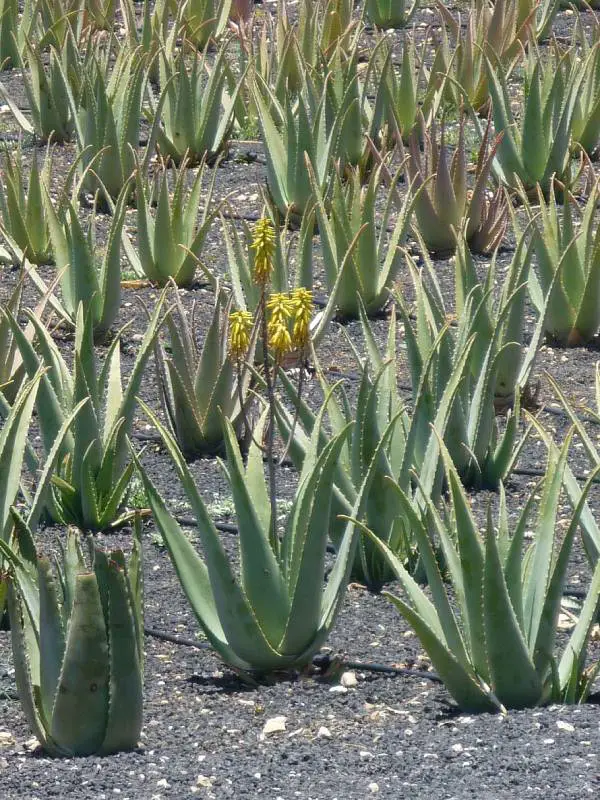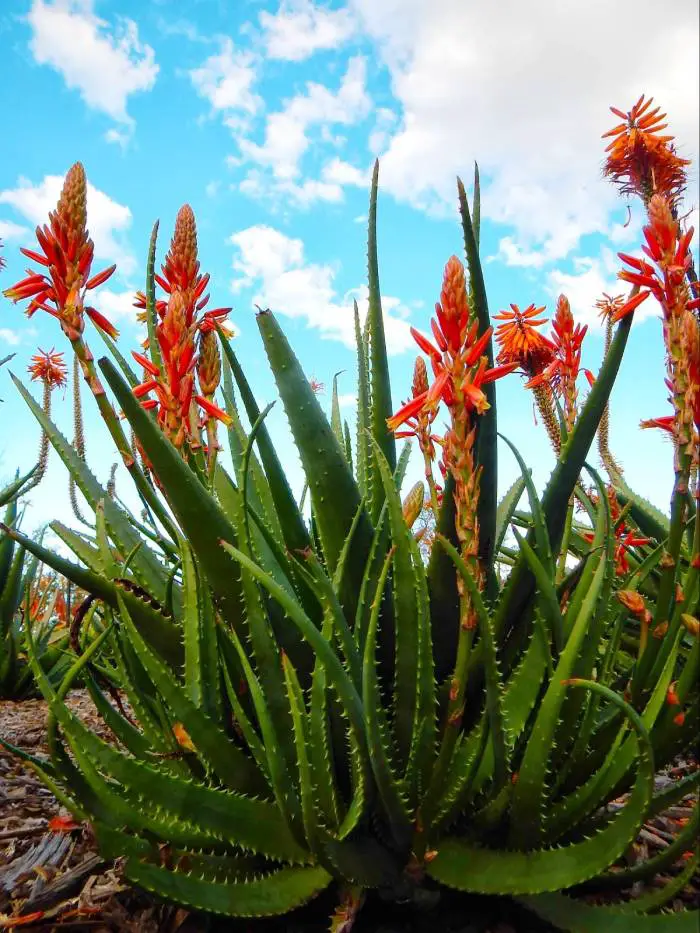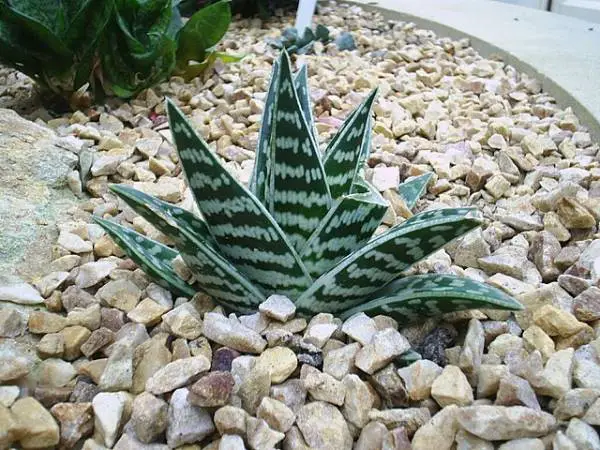The Aloe Vera plant is an attractive succulent that is a good choice both as an indoor plant and as an outdoor plant. Aloe vera plants also have health benefits and the gel extracted from their leaves is used to relieve pain, to heal burns, abrasions, etc. when applied topically. Here’s a complete guide to Aloe Vera Plant Care Outdoors and Indoor

Guide to Aloe Vera Plant Care Outdoors and Indoors
Taking proper care of aloe vera plants is very important to let the plant flourish in your home.
A succulent plant species of the genus Aloe, aloe vera is stemless or very short-stemmed with thick, greenish, fleshy leaves that originate from the plant’s central stem. The margins of the leaf are serrated.
Whenever you buy Aloe, make sure that you keep them at a sunny place, but the plant doesn’t like constant direct sunlight, as this dries the plant terribly and the leaves turn yellow, thus becoming inferior for use.
Use the gel from aloe vera leaves on your skin, but it should not be ingested by people or pets as it can cause nausea or indigestion and may be toxic in larger quantities.
How to Grow Aloe Vera Outdoors
Aloe vera can survive in arid conditions and is often used in landscaping. Outdoors, they require bright sunlight but can endure some shade. Soil should be porous and well-draining. Water sufficiently, but excess water can rot the roots. If the place where you live has a warm climate but is humid, then prefer a pot over the ground to grow your aloe vera. Keep the pot on stones to let the water runoff.
When keeping the Aloe Vera plant outdoors, make sure that it’s not drenched by the persistent rains. On rainy days, simply move the pot indoors or to a covered balcony to protect it from excess rain. In winters, the plants undergo dormancy and require less water.
How to Grow Aloe Vera Indoors?
In colder regions, grow aloe vera as a houseplant, only keeping it outdoors during the summer months. In a pot, it will grow to 1 to 2 feet in height.
Before Planting
Selecting the right type of container like a pot made from terra-cotta or any other porous material is suggested, as it dries the soil thoroughly between waterings and is also heavy to keep the plant from tipping over. A plastic or glazed pot can also be used, though these retain more moisture. The pot or container should have at least one or a few drainage holes in the bottom to drain out excess water. Though Aloe vera plants are resilient, but lack of proper drainage can result in rot or wilting, the most common cause of the death of this plant.
The container should have the same width and depth. If your aloe plant has a stem, the depth of the container should be such that to plant the entire stem under the soil. Instead of using gardening soil, the potting mix should contain perlite, chunks of bark, lava rock or all three.
It is not mandatory to put a layer of gravel, clay balls or any other drainage material in the bottom of the pot as this will only occupy the space that the roots could use otherwise, so a drainage hole will be sufficient.
(Optional) You can dust the stem of the plant with a rooting hormone powder to stimulate your aloe to develop new roots after planting. Or Use a rooting hormone that you can buy at a local garden center or online.
Planting (Replanting) An Aloe Vera Plant
When your aloe plant has grown enough, or simply needs a boost, it’s time to repot it. Here’s how:
Rinse a new pot or clean it if it is an old pot you are using again, allow it to dry thoroughly, place a small rock over the drainage hole to keep the soil from draining out and will let the water drain thoroughly.
Check the aloe vera plant to brush away any excess dirt from the roots, be careful not to harm the roots.
Separate the pups(if any) from the plant. If the stem is very long, that can’t be accommodated in the pot, cut the stem partially, although this can be risky and may even kill the plant.
Cut off some part of the stem, leaving a major part on the plant. Place the plant in a warm area that receives indirect light. After some days, a callous will be formed over the wound. Now you can plant your aloe vera. Fill the pot with a well-draining potting mix, filling in soil around the plant, leaving at least ¾ of an inch of space between the top of the soil and the rim of the pot. Ensure that the lower leaves of the aloe plant should rest just above the soil. Do not water after planting.
After potting your aloe, avoid watering it for at least a week. This will reduce the chances of rot and the plant will get time to develop new roots. keep the aloe vera plant in a warm place that gets bright but indirect light.
How To Take Care Of Aloe Vera Plant?
Let’s find out how to take care of aloe Vera plant:
Lighting:
Keep the Aloe Vera plant in bright, indirect sunlight or artificial light. A western or southern window is ideal to place your plant. If the light is low, Aloe will remain thin.
Temperature:
Aloe vera grows best in temperatures between 13°C to 27°C (55°F and 80°F). Mostly, the temperatures of houses are ideal to keep aloe vera indoors. You can keep the plant outdoors from May to September but bring it inside in the evening if the nights are cold.
Fertilizing:
Fertilize mildly only once in a month and in the spring and summer.
Aloes generally don’t need fertilization. Use a phosphorus-heavy, water-based fertilizer at half strength.
Repotting:
Repot when root bound, follow the directions as written above about planting an aloe Vera plant.
Watering Aloe Vera
- Watering is very important to keep your aloe Vera plant healthy.
- Water aloe vera plants deeply, but rarely. The soil should be moist after watering and let it dry to some extent before watering again. If the soil is excessively wet, the plant’s roots can rot.
- To ensure that you are not overwatering your plant, let the top third of potting soil dry out between waterings. For example, if your aloe vera is in 6 inches of potting soil, allow the top 2 inches to dry out before watering again. You can test the dryness of the soil with your finger.
- Water your aloe plant once in 2-3 weeks in the spring and summer and even less frequently during the fall and winter. In fall and winter, double the amount of time between waterings as compared to your summer watering schedule, like
- if you water once every two weeks in summer, then water once every four weeks in winter.
Separating & Replanting Aloe Vera Offsets(Pups)
A grown up aloe vera plant often produces offsets—also called plantlets, babies or pups that can be detached to grow a new plant.
Separate the offsets from the mother plant by using pruning shears, a sharp knife or scissors. Keep at least an inch of stem on the offset and place the offsets on a clean surface in a warm location with indirect light for a few days to allow the cut to be callous that protects them from rot. Once the offsets are callous, pot them in a succulent potting mix that is well-draining.
Place the newly-potted pups in a sunny location. Wait for at least a week to water and keep the soil dry.
How To Get Your Aloe Vera Bloom?
A grown-up aloe vera plant sometimes produces a tall flower spike, an inflorescence from which many tubular yellow or red flowers arise.

However, a bloom is rarely possible with aloes that are kept indoors, since the plant needs almost ideal conditions like ample light, adequate watering, and the right temperature range to produce flowers. Due to these needs, mostly lighting, aloe flowers are generally seen on plants grown outdoors throughout the year in warm climates.
During the day, some areas of your house get more sunlight than others. So, to make sure that your indoor plant blooms, you have to change the location of your plant to follow sunlight throughout the day. More exposure of aloe vera plants to sunlight will raise the chances of the plant blooming. In the spring and summer months, move your aloe vera plant outside, when the temperatures are above 21°C. If night temperatures become lower than 16°C, keep the aloe indoors.
Don’t shift your aloe from indoors to the full sun at once. Give it some time to acclimatize to the intense light or it will sunburn. Place it in partial shade for about a week before you move it to a sunnier location.
Make sure the plant gets an adequate amount of water.
Aloe may start to bloom in late winter or early spring, so giving them a short respite consisting of sporadic watering and cooler temperatures will boost them to flower.
Don’t be amazed, if it still doesn’t flower. No matter how hard we try, indoor conditions aren’t always ideal for most aloes to bloom.
Pests
Aloe vera plants are most prone to get infected by indoor plant pests, such as mealybugs and scales. So, in order to get them bloom, you need to take care of it from pests
Diseases
Common diseases affecting the aloe vera plant include:
- Fungal stem rot
- Root rot
- Soft rot
- Leaf rot
Overwatering should be avoided to prevent these diseases from developing or worsening. Just keep your Aloe Vera safe from the pests and diseases and they will bloom well.
Suggested Varieties of Aloe Vera
Some popular Aloe Vera Varieties are:
- Aloe Variegata: Aloe variegata is also popular as Partridge breast aloe or Tiger aloe. It is a compact aloe known for its short, smooth leaves with uneven white stripes. The variegata Tiger Aloe species have been cultivated since 1850 and is one of the first to be grown as a houseplant.

- Lace Aloe (Aloe aristata): It is a small plant with white-spotted and saw-toothed leaves. The leaves change colour with the changing weather and orange-red flowers develop on the long stems.
- Aloe vera barbadensis Miller: Aloe vera barbadensis Miller variety is usually the most beneficial variety of Aloe vera, and is also edible. It has thick, fleshy, wide, and upright leaves that are gray-green in colour and grows yellow flowers.
- Blue Aloe (Aloe glauca): It is a larger aloe species with silver-blue leaves. This is an abundantly suckering plant that has very short or no stems and rosettes about 6 ” or more in diameter.
Conclusions
Aloe vera is a magnificent plant that will add dignity to your garden, house or kitchen shelf without being much demanding in terms of care while serving the dual purpose of providing aid for minor skin problems like sunburn and also as a decorative plant. It is also used as a laxative and can be used to cure mouth ulcers.
